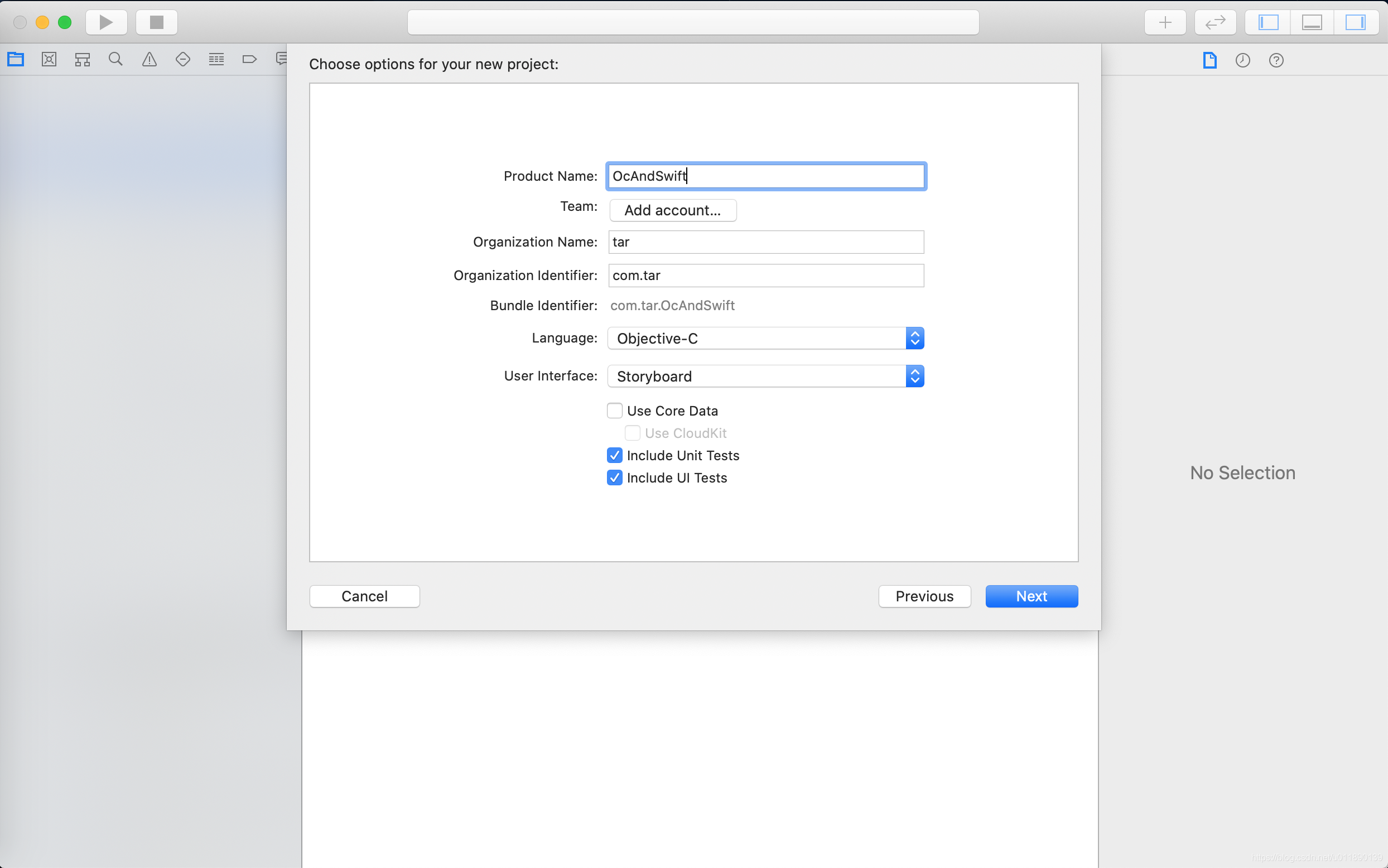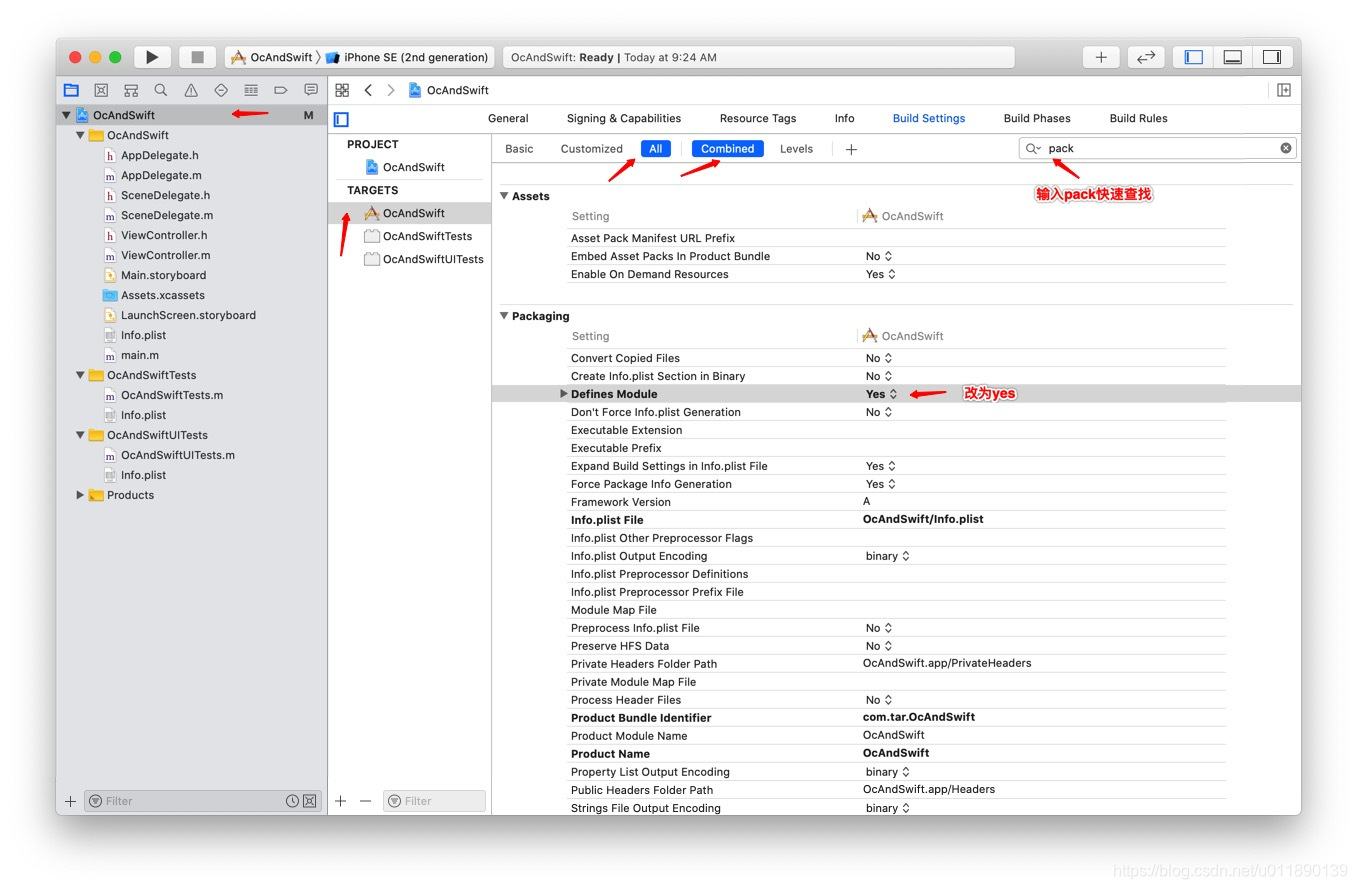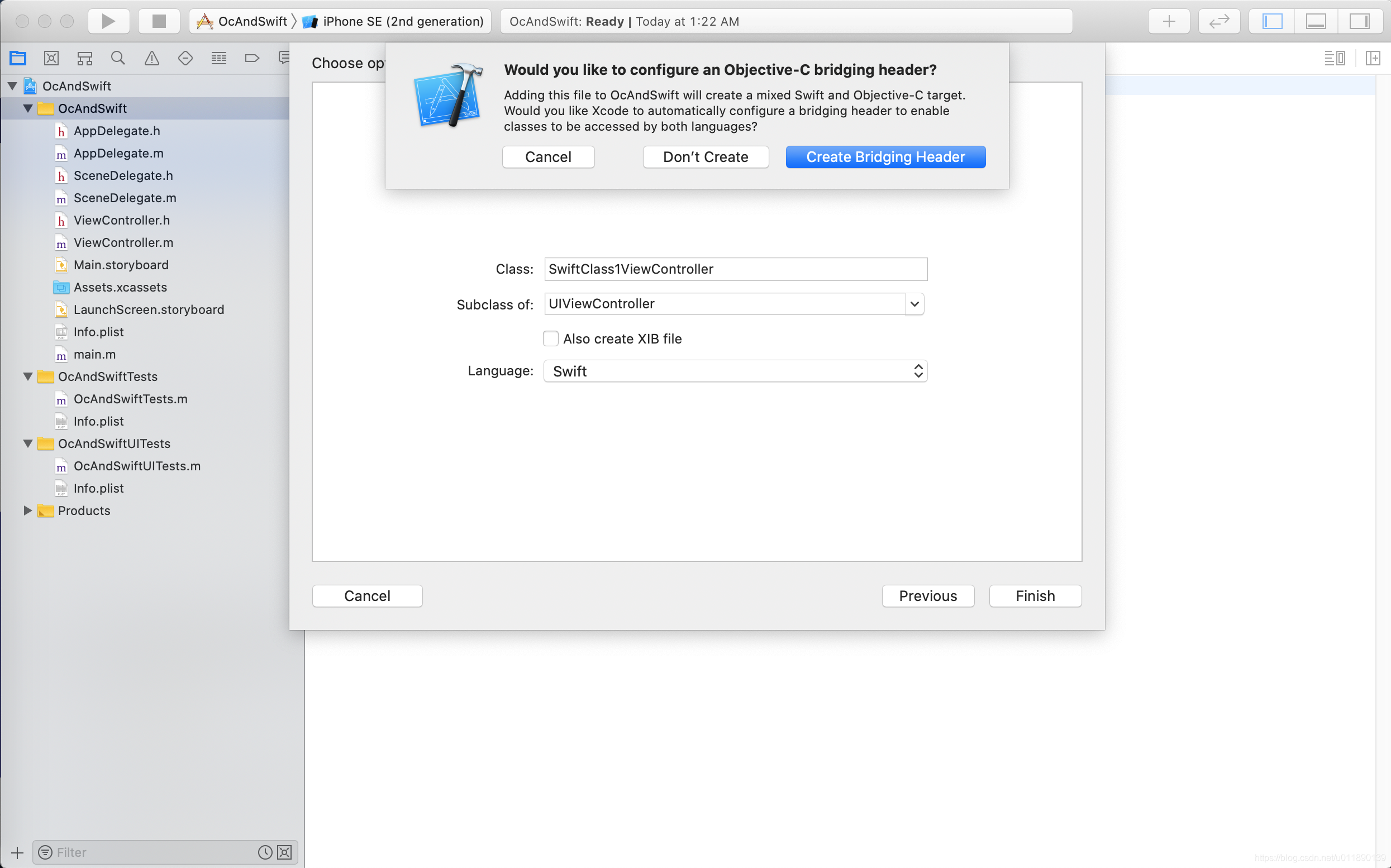oc專案中使用swift
一、為什麼寫這篇文章
我們整個移動開發團隊都在從老的語言向新的語言過度,Android團隊所有專案都在使用Kotlin開發了,但是iOS團隊還在使用OC開發專案。團隊負責人也已經發話了,iOS端從下個新專案開始都要使用swift開發了,對於基本沒怎麼使用過swift的同學來說,馬上用新語言開發專案還是有一定難度、有一定風險的。從OC和swift混編開始,從OC向swift逐漸熟悉過度,是最佳選擇,積累的經驗,降低了難度,也降低了風險!
二、Swift目前現狀
蘋果在WWDC2014正式釋出Swift,目的是用於替代OC語言。在之後的時間裡經歷了標準庫變動,語法的增減,特性變動,幾乎每一年 Swift 都會迎來比較大的改動,甚至 API 都發生了變化,讓很多第一批吃螃蟹的開發者苦不堪言,戲稱《Swift 從入門到重學》。如今已是2020年了,經過 6 年多的不斷迭代更新,WWDC2019蘋果釋出了Swift5.0,蘋果終於宣佈了Swift的穩定。這標誌著Swift這門語言已經趨於穩定,語法已經不會再大變,已經有越來越多的個人和公司在使用Swift,現在也到了重拾Swift的時候了。
三、本篇文章主要內容
1、在OC工程中設定swift需要的基本環境
2、oc和swift頁面相互跳轉,oc和swift屬性相互呼叫,oc和swift方法相互呼叫,oc和swift頁面delegate相互傳值,oc和swift頁面block相互傳值
1、環境的基本設定
1.1、新建一個基於OC的工程名為OcAndSwift,已經存在的OC工程也是一樣的。

1.2、工程設定設定

新建一個OC類OCClass1ViewController

新建一個swift類SwiftClass1ViewController.swift

完整目錄結構

2、實現 頁面相互跳轉返回,屬性相互呼叫,方法相互呼叫,delegate傳值,block傳值
2.1、程式碼實現
ViewController.m
//
// ViewController.m
// OcAndSwift
//
// Created by AiRongTang on 2020/9/29.
// Copyright © 2020 AiRongTang. All rights reserved.
//
/**
主介面
*/
#import "ViewController.h"
#import "OcAndSwift-Swift.h"
@interface ViewController ()<SwiftClass1ViewControllerDelegate>
@end
@implementation ViewController
- (void)viewDidLoad {
[super viewDidLoad];
// Do any additional setup after loading the view.
self.title = @"主頁";
[self createButton];
}
/// 建立按鈕
-(void)createButton{
//跳轉按鈕
UIButton *butotn = [UIButton buttonWithType:UIButtonTypeSystem];
[butotn addTarget:self action:@selector(buttonAction:) forControlEvents:UIControlEventTouchUpInside];
butotn.frame = CGRectMake(0, 64, 150, 40);
[butotn setTitle:@"跳轉到swift1" forState:UIControlStateNormal];
[butotn setTitleColor:[UIColor redColor] forState:UIControlStateNormal];
butotn.tag = 1;
[self.view addSubview:butotn];
//呼叫swift方法的按鈕
UIButton *ocCallButton = [UIButton buttonWithType:UIButtonTypeSystem];
[ocCallButton addTarget:self action:@selector(buttonAction:) forControlEvents:UIControlEventTouchUpInside];
ocCallButton.frame = CGRectMake(0, 64+40+10, 150, 40);
[ocCallButton setTitle:@"呼叫swift的方法" forState:UIControlStateNormal];
[ocCallButton setTitleColor:[UIColor redColor] forState:UIControlStateNormal];
ocCallButton.tag = 2;
[self.view addSubview:ocCallButton];
}
/// 按鈕點選事件
/// @param sender 點選的按鈕
-(void)buttonAction:(UIButton*)sender{
SwiftClass1ViewController *class1 = [[SwiftClass1ViewController alloc]init];
switch (sender.tag) {
case 1:{
//跳轉到Swift介面
class1.delegate = self;
[self.navigationController pushViewController:class1 animated:YES];
//實現swift類物件的block方法
class1.myBlock = ^(NSString * _Nonnull data) {
NSLog(@"myEidtorBlock==%@",data);
};
break;
}
case 2:{
//呼叫swift的方法
NSString *string = [class1 ocCallMethod:@"ocCallMethod成功"];
NSLog(@"ocCallMethodReturn==%@",string);
break;
}
default:
break;
}
}
/// 實現swift類物件的代理方法
/// @param data 接受資料
-(void)delegateMethod1:(NSString *)data{
NSLog(@"delegateMethod1==%@",data);
}
@end
SwiftClass1ViewController.swift
//
// SwiftClass1ViewController.swift
// OcAndSwift
//
// Created by AiRongTang on 2020/9/29.
// Copyright © 2020 AiRongTang. All rights reserved.
//
/**
Swift介面
*/
import UIKit
//必須加上@objc 代理才能在oc類中可見。
@objc(SwiftClass1ViewControllerDelegate)
protocol SwiftClass1ViewControllerDelegate:NSObjectProtocol {
func delegateMethod1(_ data: String);
}
//必須加上@objcMembers SwiftClass1ViewController中的屬性才能在oc類中可見。
@objcMembers
class SwiftClass1ViewController: UIViewController, OCClass1ViewControllerDelegate {
//定義delegate
var delegate:SwiftClass1ViewControllerDelegate?
//定義Block
typealias SwiftClass1ViewControllerBlock = (_ tttt:String) -> Void
var myBlock:SwiftClass1ViewControllerBlock?;
override func viewDidLoad() {
super.viewDidLoad()
// Do any additional setup after loading the view.
self.title = "swift介面1";
self.createButton()
}
/// 建立按鈕
func createButton(){
//跳轉按鈕
let btn = UIButton(frame: CGRect(x: 0, y: 100, width:150, height: 40))
btn.setTitle("跳轉到OC介面1", for: .normal);
btn.setTitleColor(UIColor.red, for: .normal);
btn.tag = 1;
view.addSubview(btn);
btn.addTarget(self, action: #selector(btnClicked), for: .touchUpInside);
//呼叫OC方法的按鈕
let swiftCallButton = UIButton(frame: CGRect(x: 0, y: 100+40+10, width:150, height: 40))
swiftCallButton.setTitle("呼叫OC的方法", for: .normal);
swiftCallButton.setTitleColor(UIColor.red, for: .normal);
swiftCallButton.tag = 2;
view.addSubview(swiftCallButton);
swiftCallButton.addTarget(self, action: #selector(btnClicked(button:)), for: .touchUpInside);
//帶資料返回按鈕
let returnButton = UIButton(frame: CGRect(x: 0, y: 100+40+40+10, width:150, height: 40))
returnButton.setTitle("帶資料返回", for: .normal);
returnButton.setTitleColor(UIColor.red, for: .normal);
returnButton.tag = 3;
view.addSubview(returnButton);
returnButton.addTarget(self, action: #selector(btnClicked(button:)), for: .touchUpInside);
}
/// 按鈕點選事件
/// - Parameter button: 點選的按鈕
@objc func btnClicked(button:UIButton){
let vc = OCClass1ViewController();
switch button.tag {
case 1 :
//跳轉到OC介面
vc.delegate = self;
vc.selectConfirmBlock = {(data:String?)in
print("selectConfirmBlock==",data!);
}
self.navigationController?.pushViewController(vc, animated: true);
case 2 :
//呼叫OC的方法
let string = vc.swiftCallMethod("swiftCallMethod成功");
print("delegateMethod1==", string);
case 3 :
//呼叫delegate返回資料
if delegate != nil {
delegate?.delegateMethod1("我是從swift頁面返回的delegate資料");
}
//呼叫block返回資料
if (self.myBlock != nil){
self.myBlock!("我是從swift頁面返回的block資料");
}
self.navigationController?.popViewController(animated: true);
default :
print("預設case")
}
}
/// 代理方法實現
/// - Parameter data: 接受資料
func delegateMethod1(_ data: String) {
print("delegateMethod1==", data);
}
/// 供OC呼叫的方法
/// - Parameter data: OC傳過來的值
/// - Returns: 返回值
@objc func ocCallMethod(_ data: String) -> String {
return data;
}
/*
// MARK: - Navigation
// In a storyboard-based application, you will often want to do a little preparation before navigation
override func prepare(for segue: UIStoryboardSegue, sender: Any?) {
// Get the new view controller using segue.destination.
// Pass the selected object to the new view controller.
}
*/
}
OCClass1ViewController.h
//
// OCClass1ViewController.h
// OcAndSwift
//
// Created by AiRongTang on 2020/9/29.
// Copyright © 2020 AiRongTang. All rights reserved.
//
/**
OC介面
*/
#import <UIKit/UIKit.h>
NS_ASSUME_NONNULL_BEGIN
///Delegate
@protocol OCClass1ViewControllerDelegate <NSObject>
-(void)delegateMethod1:(NSString *)data;
@end
///Block回撥
typedef void(^SelectConfirmBlock)(NSString *data);
@interface OCClass1ViewController : UIViewController
@property (nonatomic, copy) SelectConfirmBlock selectConfirmBlock;
@property (nonatomic, weak) id<OCClass1ViewControllerDelegate> delegate;
/// 供swift呼叫的方法
/// @param data swift傳過來的值
-(NSString *)swiftCallMethod:(NSString*)data;
@end
NS_ASSUME_NONNULL_END
OCClass1ViewController.m
//
// OCClass1ViewController.m
// OcAndSwift
//
// Created by AiRongTang on 2020/9/29.
// Copyright © 2020 AiRongTang. All rights reserved.
//
/**
OC介面
*/
#import "OCClass1ViewController.h"
@interface OCClass1ViewController ()
@end
@implementation OCClass1ViewController
- (void)viewDidLoad {
[super viewDidLoad];
// Do any additional setup after loading the view.
self.title = @"OC介面1";
[self createButton];
}
/// 建立按鈕
-(void)createButton{
UIButton *butotn = [UIButton buttonWithType:UIButtonTypeSystem];
[butotn addTarget:self action:@selector(buttonAction:) forControlEvents:UIControlEventTouchUpInside];
butotn.frame = CGRectMake(0, 64, 150, 40);
[butotn setTitle:@"帶資料返回" forState:UIControlStateNormal];
[butotn setTitleColor:[UIColor redColor] forState:UIControlStateNormal];
[self.view addSubview:butotn];
}
/// 按鈕點選事件
/// @param sender 點選的按鈕
-(void)buttonAction:(UIButton*)sender{
if (self.delegate && [self.delegate respondsToSelector:@selector(delegateMethod1:)]) {
[self.delegate delegateMethod1:@"我是從OC頁面返回的delegate資料"];
}
if (self.selectConfirmBlock) {
self.selectConfirmBlock(@"我是從OC頁面返回的block資料");
}
[self.navigationController popViewControllerAnimated:YES];
}
/// 供swift呼叫的方法
/// @param data swift傳過來的值
-(NSString *)swiftCallMethod:(NSString*)data{
return data;
}
/*
#pragma mark - Navigation
// In a storyboard-based application, you will often want to do a little preparation before navigation
- (void)prepareForSegue:(UIStoryboardSegue *)segue sender:(id)sender {
// Get the new view controller using [segue destinationViewController].
// Pass the selected object to the new view controller.
}
*/
@end
2.2、操作結果列印

2.3、注意要點
//必須加上@objc 代理才能在oc類中可見。
@objc(SwiftClass1ViewControllerDelegate)//必須加上@objcMembers SwiftClass1ViewController中的屬性才能在oc類中可見。
@objcMembers四、最後
希望大家能喜歡我分享的oc和swift混編這篇文章,希望它能為大家帶來幫助。重點在於熟悉關鍵點的設定以及swift語法的使用。好的技術有很多,好的文章也有很多,只要我們善於總結,樂於分享,發揚人人為我,我為人人的觀念,我們大家都會越來越好。
CSDN連結:https://blog.csdn.net/u011890139/article/details/108967123
demo連結:https://blog.csdn.net/u011890139/article/details/108967123